That is what I have. My speakers are on a long wall, and point across the short distance of the room. I sit against the back wall. I have diy acoustic sound absorbing panels that have Rockwool Comfortboard 80 insulation for absorption, creating the dead end back wall.
You may try any QSound CD if you have never heard it before.
It is a really fun trick that creates phantom acoustic objects outside the normal stereo basis.
Sitting in the sweet spot with speakers in the equal distances from ears gives the best effects.
And don't forget to close your eyes while listening 😉
It is a really fun trick that creates phantom acoustic objects outside the normal stereo basis.
Sitting in the sweet spot with speakers in the equal distances from ears gives the best effects.
And don't forget to close your eyes while listening 😉
Ah, yes, this is what I hear too out of this amp. A more open soundstage. Curious if you get this effect from other amps. Isn’t perceiving and hearing new sounds in the mix and getting in the groove easily more desirable than knowing your amp has ‘low’ distortion? (That is meant as a general statement; I know your mind is open)I am still listening to and enjoying this amplifier. Yesterday while listening to Bob Marley's Exodus album, during Jammin' I heard an instrument appear distinctly left of the left speaker. I could not identify the sound. It was percussive in nature, longer in duration than a drum beat and much higher in frequency, but not as high in frequency as a triangle and the decay was shorter. Perhaps it was a synthesized tone. But what caught my attention was that it stood out, and was heard distinctly to emanate from a point outside of the speaker. The perceived source location fitted with the laws of reflection of waves, whether it be light or sound.
View attachment 1288300
So some reflection in the listening room is good. 🙂
Yes, I listen for general enjoyment.
As for distortion, I started out with high distortion common source. I ended up with low distortion not because I was seeking low distortion, but because I was trying out common drain as it was something I had not done before. I ended up liking it not because it was low distortion. I ended up liking it because it sounded more real, with a more open high end, which made the music sound more live and real. Of course that may be because of the low distortion. But it was the sound that convinced me.
However this amplifier seemed to be different from my previous common source amplifiers. But this is from memory since those common source amplifiers have been changed to common drain. I do know that when I first tried common drain, I noticed the difference in sound immediately. With this amp, the sound was not noticeably different from THF-51S mu follower follower that I had been listening to.
So I put the THF-51S mu follower follower back in. Similar except common drain, 62V PS, 2.5A, and much more power, lower distortion. Sound is a bit fuller, realism a bit higher, at least that is the first impression. Soundstage is also wide and floats - not stuck to the speakers. The Bob Marley song's virtual image is also prominent. So I would not say that the common source version is superior. Of course this is comparing my builds in my system.
If I had to choose only one amp of the two to keep, I would keep the common drain mu follower follower. But the lower powered common source amp is still very good, and I would listen happily to either one. I also enjoy listening to my other amps too throughout the year. With the amps that I have now, I enjoy their sound regardless of which is in play at the time. The choice depends on the seasonal temperatures and heat dissipation.
And I don't have to choose only one amp to keep. 🙂
As for distortion, I started out with high distortion common source. I ended up with low distortion not because I was seeking low distortion, but because I was trying out common drain as it was something I had not done before. I ended up liking it not because it was low distortion. I ended up liking it because it sounded more real, with a more open high end, which made the music sound more live and real. Of course that may be because of the low distortion. But it was the sound that convinced me.
However this amplifier seemed to be different from my previous common source amplifiers. But this is from memory since those common source amplifiers have been changed to common drain. I do know that when I first tried common drain, I noticed the difference in sound immediately. With this amp, the sound was not noticeably different from THF-51S mu follower follower that I had been listening to.
So I put the THF-51S mu follower follower back in. Similar except common drain, 62V PS, 2.5A, and much more power, lower distortion. Sound is a bit fuller, realism a bit higher, at least that is the first impression. Soundstage is also wide and floats - not stuck to the speakers. The Bob Marley song's virtual image is also prominent. So I would not say that the common source version is superior. Of course this is comparing my builds in my system.
If I had to choose only one amp of the two to keep, I would keep the common drain mu follower follower. But the lower powered common source amp is still very good, and I would listen happily to either one. I also enjoy listening to my other amps too throughout the year. With the amps that I have now, I enjoy their sound regardless of which is in play at the time. The choice depends on the seasonal temperatures and heat dissipation.
And I don't have to choose only one amp to keep. 🙂
September is here and the temperature has dropped a bit. So after months of enjoying my summer amp (https://www.diyaudio.com/community/...amplifier-with-cascode-and-choke-load.402309/), it is time to enjoy this amp.
Prior to putting it back into my system, I upgraded the power supply. The original power supply was a bipolar CLC filter that was in the chassis when it was a SissySIT,and then a Redneck DefiSIT. In its current incarnation the bipolar power supply was used in unipolar mode, with the V- serving as ground. The disadvantage of this was a reduction in power supply filtration and increase in supply ripple. In my system with high sensitivity speakers (103dB), I could hear a bit of noise with the high gain DIY Front End 2022 as the preamp but no noise with the low gain ACP+ as the preamp.
So I built a unipolar CLC filter comprising 2x22mF 50V - Hammond 156B - 2x22mF 50V. The Hammond 156B is the same choke that was in the bipolar CLC filter. According to my LTSpice simulations, the bipolar supply used unipolarly had a ripple of 11mVpp and the new unipolar supply had a ripple of 6mVpp. The Hammond 156B has an inductance of only 1.5mH but the reduction in ripple was enough to lower the noise to an inaudible level in my system.
Not only that the unipolar supply reduced the supply ripple and subsequent system noise, but it reduced the number of parts in the power supply, and it also increased the power supply voltage using the same power transformer. The increased voltage was due to only one bridge rectifier and choke per channel instead of two of each, so half of the voltage drop due to rectifiers and chokes. The power supply voltage under load went from 44V to 47V. I did not change the Iq or Vds of the THF-51S so the mosfet now sees a higher Vds. That changes the operation of the amplifier a bit, but I decided not to tweak it more. One advantage is a bit higher power output. Perhaps raising the THF-51S Vds would lower the distortion a bit at the expense of power output but I decided not to bother with it.
I also twisted the two power transformers a bit to find their positions of lowest noise.
One possible tweak that would probably lower the distortion is to replace the paralleled J113 in the input buffer position with a single Toshiba or Linear Systems SK170. Perhaps one day I will give that a try as LSK170s are readily available from Mouser now.
I have been listening to this amp for a few days now and initially it did sound a bit different from the replaced amp. I think that was due to the higher distortion of this amp. Since I had installed optional feedback resistors allowing for approximately 4dB or 6dB of feedback, I gave that a try. I know that some people abhor feedback, but then some people abhor distortion. In my system and to my ears, some music can tolerate higher levels of distortion and some music is more enjoyable when the distortion is lower, allowing for more clarity. So I tend to listen to this amp with some feedback as I have become accustomed to music reproduced with lower levels of distortion (as demonstrated by my shift of preference from common source amps to common drain (follower) amps).
It is interesting though that Nelson started out with feedback in his SIT-4 but then went with no feedback in his production amp as his listeners preferred the no feedback version. But hey, different ears, different brain, different system, different music. We are free to make our choices. And I can choose feedback or no feedback with the flick of a switch.
Anyways, here are the latest distortion plots with the new power supply pumping out 47+VDC, with no feedback. I stopped at 15W at 8 Ohm although higher power output at higher distortion was possible. But no one would want to listen to such high distortion.
Prior to putting it back into my system, I upgraded the power supply. The original power supply was a bipolar CLC filter that was in the chassis when it was a SissySIT,and then a Redneck DefiSIT. In its current incarnation the bipolar power supply was used in unipolar mode, with the V- serving as ground. The disadvantage of this was a reduction in power supply filtration and increase in supply ripple. In my system with high sensitivity speakers (103dB), I could hear a bit of noise with the high gain DIY Front End 2022 as the preamp but no noise with the low gain ACP+ as the preamp.
So I built a unipolar CLC filter comprising 2x22mF 50V - Hammond 156B - 2x22mF 50V. The Hammond 156B is the same choke that was in the bipolar CLC filter. According to my LTSpice simulations, the bipolar supply used unipolarly had a ripple of 11mVpp and the new unipolar supply had a ripple of 6mVpp. The Hammond 156B has an inductance of only 1.5mH but the reduction in ripple was enough to lower the noise to an inaudible level in my system.
Not only that the unipolar supply reduced the supply ripple and subsequent system noise, but it reduced the number of parts in the power supply, and it also increased the power supply voltage using the same power transformer. The increased voltage was due to only one bridge rectifier and choke per channel instead of two of each, so half of the voltage drop due to rectifiers and chokes. The power supply voltage under load went from 44V to 47V. I did not change the Iq or Vds of the THF-51S so the mosfet now sees a higher Vds. That changes the operation of the amplifier a bit, but I decided not to tweak it more. One advantage is a bit higher power output. Perhaps raising the THF-51S Vds would lower the distortion a bit at the expense of power output but I decided not to bother with it.
I also twisted the two power transformers a bit to find their positions of lowest noise.
One possible tweak that would probably lower the distortion is to replace the paralleled J113 in the input buffer position with a single Toshiba or Linear Systems SK170. Perhaps one day I will give that a try as LSK170s are readily available from Mouser now.
I have been listening to this amp for a few days now and initially it did sound a bit different from the replaced amp. I think that was due to the higher distortion of this amp. Since I had installed optional feedback resistors allowing for approximately 4dB or 6dB of feedback, I gave that a try. I know that some people abhor feedback, but then some people abhor distortion. In my system and to my ears, some music can tolerate higher levels of distortion and some music is more enjoyable when the distortion is lower, allowing for more clarity. So I tend to listen to this amp with some feedback as I have become accustomed to music reproduced with lower levels of distortion (as demonstrated by my shift of preference from common source amps to common drain (follower) amps).
It is interesting though that Nelson started out with feedback in his SIT-4 but then went with no feedback in his production amp as his listeners preferred the no feedback version. But hey, different ears, different brain, different system, different music. We are free to make our choices. And I can choose feedback or no feedback with the flick of a switch.
Anyways, here are the latest distortion plots with the new power supply pumping out 47+VDC, with no feedback. I stopped at 15W at 8 Ohm although higher power output at higher distortion was possible. But no one would want to listen to such high distortion.
Attachments
-
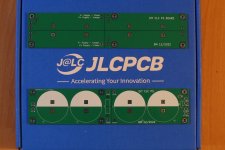 Unipolar PS PCB.JPG270.8 KB · Views: 92
Unipolar PS PCB.JPG270.8 KB · Views: 92 -
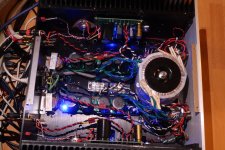 LV BAF20215 THF-51S revised PS.JPG428.5 KB · Views: 82
LV BAF20215 THF-51S revised PS.JPG428.5 KB · Views: 82 -
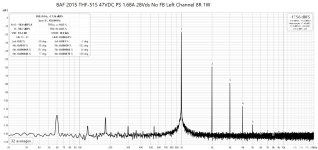 BAF 2015 THF-51S 47VDC PS No FB 1.68A Vds 28V Left Channel 8R 1W.jpg241.7 KB · Views: 74
BAF 2015 THF-51S 47VDC PS No FB 1.68A Vds 28V Left Channel 8R 1W.jpg241.7 KB · Views: 74 -
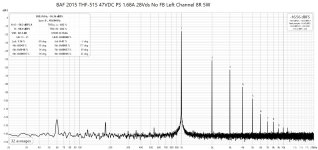 BAF 2015 THF-51S 47VDC PS No FB 1.68A Vds 28V Left Channel 8R 5W.jpg241.5 KB · Views: 60
BAF 2015 THF-51S 47VDC PS No FB 1.68A Vds 28V Left Channel 8R 5W.jpg241.5 KB · Views: 60 -
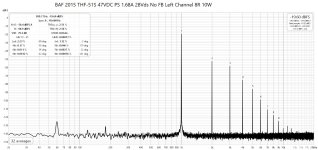 BAF 2015 THF-51S 47VDC PS No FB 1.68A Vds 28V Left Channel 8R 10W.jpg240.5 KB · Views: 57
BAF 2015 THF-51S 47VDC PS No FB 1.68A Vds 28V Left Channel 8R 10W.jpg240.5 KB · Views: 57 -
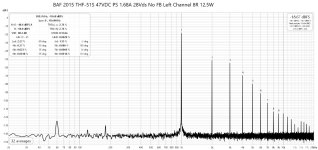 BAF 2015 THF-51S 47VDC PS No FB 1.68A Vds 28V Left Channel 8R 12.5W.jpg241.7 KB · Views: 58
BAF 2015 THF-51S 47VDC PS No FB 1.68A Vds 28V Left Channel 8R 12.5W.jpg241.7 KB · Views: 58 -
 BAF 2015 THF-51S 47VDC PS No FB 1.68A Vds 28V Left Channel 8R 15W.jpg241.1 KB · Views: 74
BAF 2015 THF-51S 47VDC PS No FB 1.68A Vds 28V Left Channel 8R 15W.jpg241.1 KB · Views: 74
Last edited:
Right Channel No Feedback:
Attachments
-
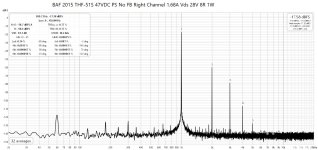 BAF 2015 THF-51S 47VDC PS No FB 1.68A Vds 28V Right Channel 8R 1W.jpg243.3 KB · Views: 45
BAF 2015 THF-51S 47VDC PS No FB 1.68A Vds 28V Right Channel 8R 1W.jpg243.3 KB · Views: 45 -
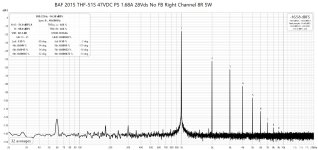 BAF 2015 THF-51S 47VDC PS No FB 1.68A Vds 28V Right Channel 8R 5W.jpg241.7 KB · Views: 44
BAF 2015 THF-51S 47VDC PS No FB 1.68A Vds 28V Right Channel 8R 5W.jpg241.7 KB · Views: 44 -
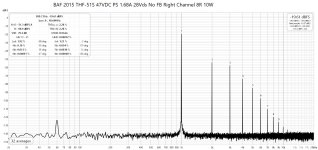 BAF 2015 THF-51S 47VDC PS No FB 1.68A Vds 28V Right Channel 8R 10W.jpg242 KB · Views: 43
BAF 2015 THF-51S 47VDC PS No FB 1.68A Vds 28V Right Channel 8R 10W.jpg242 KB · Views: 43 -
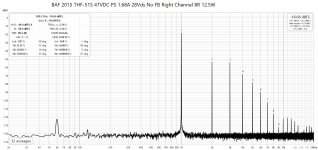 BAF 2015 THF-51S 47VDC PS No FB 1.68A Vds 28V Right Channel 8R 12.5W.jpg241.4 KB · Views: 44
BAF 2015 THF-51S 47VDC PS No FB 1.68A Vds 28V Right Channel 8R 12.5W.jpg241.4 KB · Views: 44 -
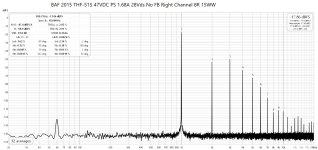 BAF 2015 THF-51S 47VDC PS No FB 1.68A Vds 28V Right Channel 8R 15W.jpg242.2 KB · Views: 47
BAF 2015 THF-51S 47VDC PS No FB 1.68A Vds 28V Right Channel 8R 15W.jpg242.2 KB · Views: 47
I know that some people abhor feedback
luckily, you're not "some" to yourself, so - who cares

I have to admit I was trying for that. 🙂
As mentioned it might be possible to lower it a bit and get even closer by replacing the paralleled J113 input buffer with a SK170.
As mentioned it might be possible to lower it a bit and get even closer by replacing the paralleled J113 input buffer with a SK170.
The good thing about diy is that you can choose what's best for you. 🤓
Have you done any comparison distortion measurements? It is always interesting to compare qualitative to quantitative results.
No, I did not. From Spice, the distortion is in the 0.00x% range at high swings. And I believe it (mainly because Spice was correct on the magnitude of distortion of the same JFET used for gain). From listening, they were both pretty transparent from a distortion perspective, nothing objectionable at all, but they both clearly added a character to the sound.
- Home
- Amplifiers
- Pass Labs
- BAF2015 Amplifier - A SIT Mu Follower, Revisited with Feedback
 I use Madonna's Vogue as a test track. Neat stuff.
I use Madonna's Vogue as a test track. Neat stuff.